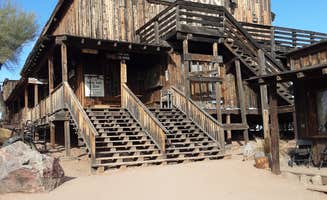The Fountain Hills area sits at approximately 1,800 feet elevation in the eastern Phoenix metropolitan area, where the Sonoran Desert meets the foothills of the McDowell Mountains. Camping options near Fountain Hills provide access to diverse desert landscapes with temperatures ranging from below freezing in winter nights to over 110°F in summer afternoons. Many campgrounds remain open year-round despite the extreme temperature variations.
What to do
Desert hiking trails: 10+ miles of trails at Cave Creek Regional Park offer options for all skill levels. "The park has beautiful hiking trails and a great nature center, which offers activities. Some hiking trails are within walking distance of the campground, others you will need to drive to," notes Ellen W.
Horseback riding opportunities: Several trails at Cave Creek Group Site accommodate equestrians. "Our site had a view of a trail where we watched equestrians ride by sporadically throughout the evening. We saw some snakes, coyotes, and other wildlife," mentions Don M.
Stargazing sessions: Winter months provide optimal night sky viewing conditions when humidity is low. "Campsite is clean and very easy to reserve ahead of time on the supported website which is very easy to use and see all the items open," shares Brad B., who visited Lost Dutchman State Park to enjoy the dark skies.
What campers like
Proximity to urban conveniences: Many glamping sites near Fountain Hills maintain a balance between seclusion and access to necessities. "Gated at night, feels safe. Surrounded by homes but for its proximity to town its sunset views are fab. Close to a Frys and Home Depot," reports Kiley S. about White Tank Mountain.
Spacious desert campsites: Sites typically provide adequate separation from neighbors. "The sites are spacious and spaced well enough apart from each other," explains Kristin C. about her experience at Cave Creek Regional Park.
Educational opportunities: Visitor centers offer programming for both adults and children. "I've also joined two ranger-led hikes here (Black Rock Loop for sunrise hikes) as well as a county-sponsored astronomy night with access to multiple large telescopes and an astronomy presentation," shares Chenery K. about White Tank Mountain.
What you should know
Gate closure times affect access: Several parks lock entrance gates at night. "Nothing on website said gate closes and can't get back in after 9 pm," warns Nicole E. about Cave Creek Regional Park, highlighting the importance of checking park policies.
Winter reservations require advance planning: Between November and March, campgrounds fill quickly. "Suggest you make reservations well ahead for busy winter months!" advises Debbie W. about Lost Dutchman State Park Campground.
Water taste varies by location: Some campers note differences in water quality. "Bring lots of water. Though there are fresh water stations around, the water seemed to have an odd taste to me," recommends Crystal C. at White Tank Mountain.
Tips for camping with families
Nature centers provide kid-friendly activities: Many regional parks offer educational programming. "The park has a large Nature Center with lots of desert creatures inside including a big fat rattlesnake, gila monster, black widow spider and some scorpions to safely check out up close," explains Chenery K. about Mesquite Campground.
Playgrounds available at select locations: Some parks include recreational facilities beyond hiking. "There are a couple of playgrounds in the park as well," notes Ellen W. about White Tank Mountain.
Noise levels vary by campground: Some areas experience more disturbances than others. "Camped here with my family. The scenery was beautiful, but didn't love the fact that people were blaring their music here until 2AM in the morning," reports Brandon M. at Lost Dutchman State Park Campground.
Tips from RVers
Site selection considerations: Review campground maps carefully before booking. "Carefully review the site you select to be sure it will accommodate your rig. Roads are narrow and there are unforgiving drop offs on the sides," advises Terri D. from Usery Mountain Regional Park.
Hookup availability varies: Electric and water services differ between locations. "Our spot was a pull through...more a side of the road spot. No shade here at all but otherwise pretty decent. My spot had water and electric. Nice dump station on the way out too," shares Chris P. about his stay at Usery Mountain Regional Park.
Shade limitations: Desert camping generally means limited natural cover. "My site had no shade which was ok when I visited in early spring but would have been way too hot to have stayed here during late spring or summer," notes Crystal C. about White Tank Mountain campground.



